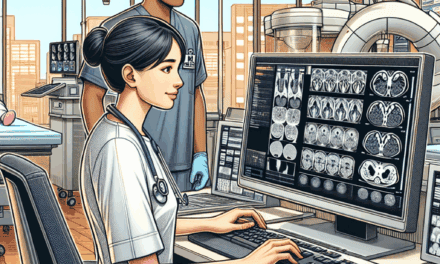AI Innovations in EHR: Boosting Practice Efficiency

The integration of Artificial Intelligence (AI) into Electronic Health Records (EHR) systems is revolutionizing the healthcare industry. By enhancing practice efficiency, AI-driven EHR systems are transforming how healthcare providers manage patient data, streamline workflows, and improve patient outcomes. This article delves into the various AI innovations in EHR, exploring how they are boosting practice efficiency and reshaping the healthcare landscape.
1. Automating Administrative Tasks
One of the most significant impacts of AI in EHR systems is the automation of administrative tasks. These tasks, which traditionally consume a substantial amount of time and resources, can now be streamlined through AI technologies, allowing healthcare professionals to focus more on patient care.
1.1 Streamlining Data Entry
Data entry is a critical yet time-consuming task in healthcare settings. AI-powered EHR systems can automate data entry processes by using natural language processing (NLP) to transcribe and input data from voice recordings or written notes. This reduces the burden on healthcare providers and minimizes the risk of human error.
For instance, AI algorithms can analyze physician-patient interactions and automatically update patient records with relevant information. This not only saves time but also ensures that patient data is accurate and up-to-date.
1.2 Scheduling and Appointment Management
AI-driven EHR systems can optimize scheduling and appointment management by analyzing patient data and predicting appointment durations. This allows healthcare providers to allocate time slots more efficiently, reducing wait times and improving patient satisfaction.
Moreover, AI can identify patterns in patient no-shows and suggest strategies to minimize them, such as sending automated reminders or offering flexible scheduling options.
1.3 Billing and Coding
Billing and coding are complex processes that require precision and accuracy. AI technologies can automate these tasks by analyzing patient records and generating accurate billing codes. This reduces the likelihood of errors and ensures that healthcare providers receive timely reimbursements.
AI can also identify discrepancies in billing data and flag potential issues for further review, helping healthcare organizations maintain compliance with regulatory standards.
1.4 Inventory Management
Effective inventory management is crucial for healthcare facilities to ensure that they have the necessary supplies and medications on hand. AI-powered EHR systems can track inventory levels in real-time, predict future needs based on historical data, and automate reordering processes.
This not only reduces the risk of stockouts but also minimizes waste by preventing overstocking of perishable items.
1.5 Enhancing Communication
AI can facilitate communication between healthcare providers, patients, and administrative staff by automating routine messages and notifications. For example, AI-driven chatbots can handle patient inquiries, provide appointment reminders, and deliver test results, freeing up staff to focus on more complex tasks.
By improving communication efficiency, AI helps ensure that patients receive timely information and support, enhancing their overall experience with the healthcare system.
2. Enhancing Clinical Decision-Making
AI innovations in EHR systems are not only streamlining administrative tasks but also enhancing clinical decision-making. By providing healthcare providers with data-driven insights, AI is helping to improve patient outcomes and optimize treatment plans.
2.1 Predictive Analytics
Predictive analytics is a powerful tool that leverages AI algorithms to analyze patient data and identify potential health risks. By predicting the likelihood of certain conditions or complications, healthcare providers can take proactive measures to prevent adverse outcomes.
For example, AI can analyze a patient’s medical history, lifestyle factors, and genetic information to predict their risk of developing chronic diseases such as diabetes or heart disease. This allows providers to implement preventive measures and tailor treatment plans to individual patients.
2.2 Personalized Treatment Plans
AI-driven EHR systems can analyze vast amounts of patient data to identify patterns and correlations that may not be immediately apparent to human clinicians. This enables the development of personalized treatment plans that are tailored to each patient’s unique needs and circumstances.
By considering factors such as genetic predispositions, lifestyle choices, and previous treatment responses, AI can help healthcare providers make more informed decisions about the most effective treatment options for their patients.
2.3 Clinical Decision Support Systems
Clinical decision support systems (CDSS) are AI-powered tools that provide healthcare providers with evidence-based recommendations and alerts. These systems can analyze patient data in real-time and offer guidance on diagnosis, treatment options, and potential drug interactions.
By integrating CDSS into EHR systems, healthcare providers can access valuable insights that enhance their decision-making processes and improve patient care.
2.4 Early Detection of Diseases
AI technologies can assist in the early detection of diseases by analyzing medical images, lab results, and other diagnostic data. For instance, AI algorithms can identify subtle patterns in radiology images that may indicate the presence of tumors or other abnormalities.
Early detection allows for timely intervention, which can significantly improve patient outcomes and reduce the overall cost of care.
2.5 Reducing Diagnostic Errors
Diagnostic errors are a significant concern in healthcare, leading to delayed treatment and adverse patient outcomes. AI-driven EHR systems can help reduce diagnostic errors by cross-referencing patient data with vast medical databases and providing clinicians with potential diagnoses and treatment options.
This not only enhances diagnostic accuracy but also supports healthcare providers in making more informed decisions about patient care.
3. Improving Patient Engagement
AI innovations in EHR systems are also playing a crucial role in improving patient engagement. By empowering patients with access to their health information and personalized insights, AI is fostering a more collaborative and informed approach to healthcare.
3.1 Patient Portals
AI-powered patient portals provide patients with easy access to their health records, test results, and treatment plans. These portals enable patients to actively participate in their healthcare journey by allowing them to review their medical history, track their progress, and communicate with their healthcare providers.
By promoting transparency and accessibility, patient portals enhance patient engagement and encourage individuals to take a more active role in managing their health.
3.2 Personalized Health Insights
AI-driven EHR systems can analyze patient data to generate personalized health insights and recommendations. For example, AI algorithms can assess a patient’s lifestyle habits, genetic predispositions, and medical history to provide tailored advice on diet, exercise, and preventive measures.
These personalized insights empower patients to make informed decisions about their health and well-being, leading to improved outcomes and a higher quality of life.
3.3 Remote Monitoring and Telehealth
AI technologies are facilitating remote monitoring and telehealth services, allowing patients to receive care from the comfort of their homes. AI-driven EHR systems can collect and analyze data from wearable devices, such as heart rate monitors and glucose sensors, to provide real-time insights into a patient’s health status.
This enables healthcare providers to monitor patients remotely, identify potential issues early, and intervene as needed, reducing the need for in-person visits and improving access to care.
3.4 Virtual Health Assistants
AI-powered virtual health assistants can engage with patients through chatbots or voice-activated devices, providing information and support on various health-related topics. These virtual assistants can answer questions, offer medication reminders, and guide patients through self-care routines.
By providing round-the-clock support, virtual health assistants enhance patient engagement and ensure that individuals have access to the information they need to manage their health effectively.
3.5 Enhancing Patient Education
AI-driven EHR systems can deliver personalized educational content to patients based on their medical history, treatment plans, and health goals. This content can include articles, videos, and interactive tools that help patients better understand their conditions and treatment options.
By enhancing patient education, AI empowers individuals to make informed decisions about their health and fosters a more collaborative relationship between patients and healthcare providers.
4. Optimizing Workflow Efficiency
AI innovations in EHR systems are optimizing workflow efficiency by automating routine tasks, streamlining processes, and reducing administrative burdens. This allows healthcare providers to focus on delivering high-quality care and improving patient outcomes.
4.1 Workflow Automation
AI-driven EHR systems can automate various aspects of healthcare workflows, such as appointment scheduling, patient check-ins, and documentation. By automating these tasks, healthcare providers can reduce administrative burdens and allocate more time to patient care.
For example, AI algorithms can automatically generate clinical notes based on physician-patient interactions, reducing the time spent on documentation and ensuring that records are accurate and up-to-date.
4.2 Task Prioritization
AI technologies can analyze patient data and prioritize tasks based on urgency and importance. This allows healthcare providers to focus on critical tasks and allocate resources more effectively, improving overall workflow efficiency.
By identifying high-priority patients and tasks, AI-driven EHR systems help ensure that healthcare providers can deliver timely and appropriate care to those who need it most.
4.3 Reducing Redundancies
AI-powered EHR systems can identify and eliminate redundancies in healthcare workflows, such as duplicate tests or procedures. By streamlining processes and reducing unnecessary steps, AI helps healthcare providers optimize their workflows and improve efficiency.
This not only reduces costs but also enhances the patient experience by minimizing wait times and ensuring that care is delivered promptly.
4.4 Enhancing Collaboration
AI technologies facilitate collaboration among healthcare providers by enabling seamless data sharing and communication. AI-driven EHR systems can integrate data from various sources, such as labs, imaging centers, and specialists, to provide a comprehensive view of a patient’s health status.
This enhances collaboration among care teams, allowing them to make more informed decisions and deliver coordinated care to patients.
4.5 Continuous Improvement
AI-driven EHR systems can continuously analyze workflow data to identify areas for improvement and suggest strategies for optimization. By leveraging machine learning algorithms, these systems can adapt to changing conditions and provide actionable insights for enhancing workflow efficiency.
This continuous improvement process ensures that healthcare providers can maintain high levels of efficiency and deliver the best possible care to their patients.
5. Ensuring Data Security and Privacy
As AI innovations in EHR systems continue to advance, ensuring data security and privacy remains a top priority. AI technologies are playing a crucial role in safeguarding patient information and maintaining compliance with regulatory standards.
5.1 Data Encryption
AI-driven EHR systems employ advanced encryption techniques to protect patient data from unauthorized access. By encrypting data both at rest and in transit, AI technologies ensure that sensitive information remains secure and confidential.
This is particularly important in healthcare settings, where the protection of patient data is critical to maintaining trust and compliance with regulations such as the Health Insurance Portability and Accountability Act (HIPAA).
5.2 Anomaly Detection
AI algorithms can analyze network traffic and user behavior to detect anomalies that may indicate potential security threats. By identifying unusual patterns or activities, AI-driven EHR systems can alert security teams to potential breaches and enable them to take proactive measures to mitigate risks.
This enhances the overall security posture of healthcare organizations and helps protect patient data from cyber threats.
5.3 Access Control
AI technologies can enhance access control measures by implementing advanced authentication methods, such as biometric verification or multi-factor authentication. This ensures that only authorized individuals can access sensitive patient information, reducing the risk of data breaches.
By strengthening access control measures, AI-driven EHR systems help healthcare organizations maintain compliance with regulatory standards and protect patient privacy.
5.4 Data Auditing
AI-powered EHR systems can automate data auditing processes by continuously monitoring access logs and user activities. This enables healthcare organizations to identify potential security incidents and ensure that data access is in compliance with established policies and regulations.
By providing real-time insights into data access and usage, AI technologies help healthcare organizations maintain transparency and accountability in their data management practices.
5.5 Compliance with Regulations
AI-driven EHR systems can assist healthcare organizations in maintaining compliance with regulatory standards by automating documentation and reporting processes. AI technologies can generate compliance reports, track regulatory changes, and ensure that data management practices align with industry standards.
This not only reduces the administrative burden on healthcare organizations but also ensures that they remain compliant with regulations such as HIPAA and the General Data Protection Regulation (GDPR).
Conclusion
AI innovations in EHR systems are transforming the healthcare industry by boosting practice efficiency and enhancing patient care. From automating administrative tasks to improving clinical decision-making, AI technologies are streamlining workflows and empowering healthcare providers to deliver high-quality care. By improving patient engagement, optimizing workflow efficiency, and ensuring data security and privacy, AI-driven EHR systems are reshaping the healthcare landscape and paving the way for a more efficient and effective healthcare system.
As AI technologies continue to evolve, their integration into EHR systems will undoubtedly lead to further advancements in healthcare delivery and patient outcomes. By embracing these innovations, healthcare organizations can enhance their practice efficiency and provide better care to their patients.





